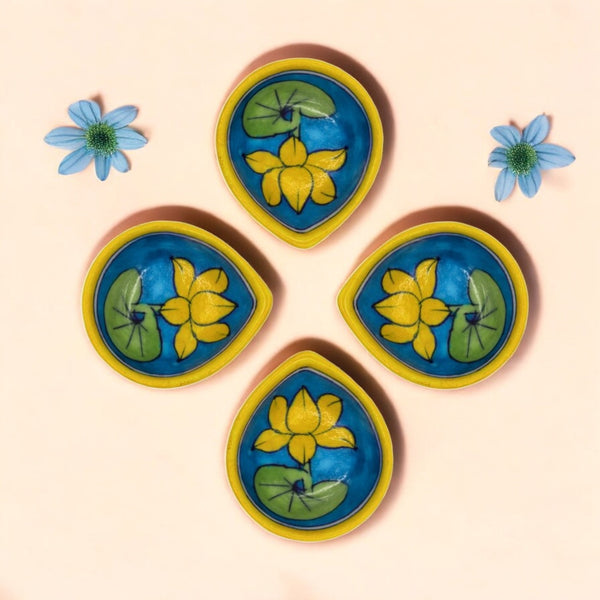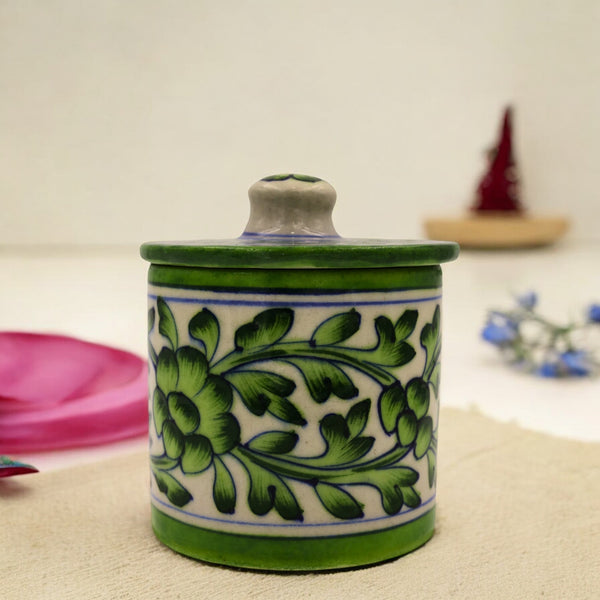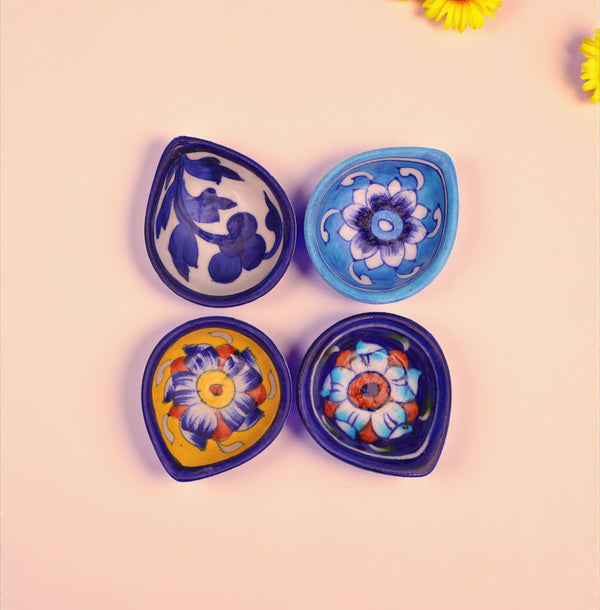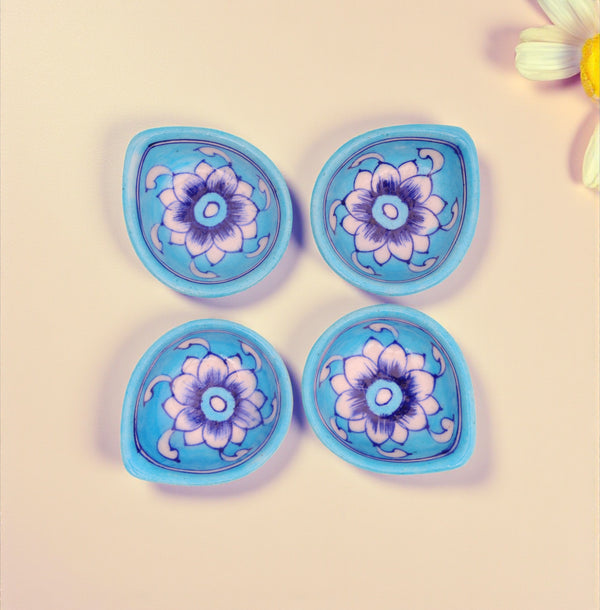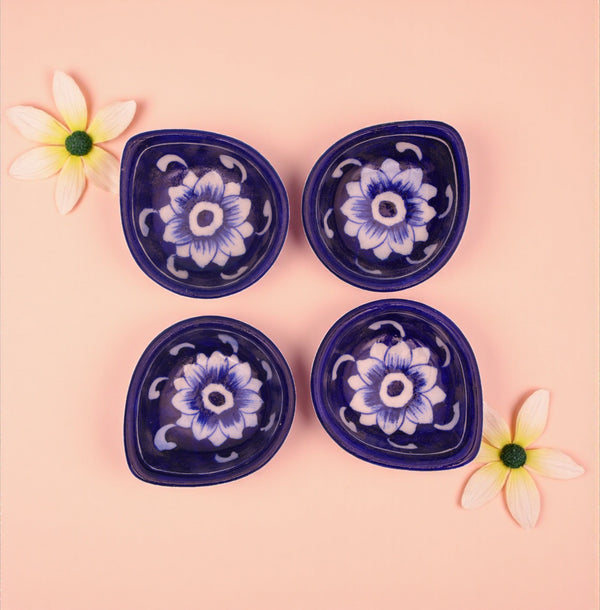Showing 264 products
Add a touch of elegance to your dining table with our exquisite oval decorative plate. Crafted from natural materials like Multani mitti and stone quartz powder, this handcrafted piece features a vibrant turquoise color and intricate floral designs. This versatile...
Enhance your decor with our stunning blue pottery yellow T-light candle holder. Adorned with white and blue floral pattern, this exquisite piece combines elegance and charm. Ideal for adding warmth and sophistication to any room, it turns everyday moments into...
Add an enchanting touch to your home decor with our exquisite Blue Pottery diyas from Jaipur, India. Intricately hand-painted in yellow and white color along with sky blue leafy patterns, these unique diyas blend tradition with contemporary style. Perfect for...
Add an enchanting touch to your home decor with our exquisite Blue Pottery diyas from Jaipur, India. Intricately hand-painted in Yellow and Sky-Blue color along with lotus flower design, these unique diyas blend tradition with contemporary style. Perfect for festive...
This handcrafted Blue Pottery Jar is a striking piece that brings elegance to any space. Featuring intricate green floral designs on a vibrant white background, it is a unique and captivating addition to your home decor. Use it to store...
Unlock the charm of tradition with this exquisite oval blue pottery plate, adorned with vibrant floral designs against a crisp white backdrop. Versatile as both décor and a serving dish, it embodies Jaipur's artisan heritage and makes a thoughtful gift....
Add variety and elegance to your festive décor with this Assorted Pack of 4 Blue Pottery Diyas, handmade in Jaipur. Each diya in the set comes in a different design and color combination, making the collection vibrant and unique. From...
Brighten your festive celebrations with this set of 4 Sky Blue Blue Pottery Diyas, handcrafted in Jaipur. Each diya is leaf-shaped and hand-painted with delicate floral motifs in purple and white, set against a glossy sky-blue glaze that exudes elegance....
Illuminate your celebrations with this set of 4 Blue Pottery Diyas in a striking deep blue glaze. Each diya is leaf-shaped and hand-painted with delicate floral motifs, reflecting the rich tradition of Jaipur’s Blue Pottery craft. Made from a unique...
Blue pottery
“Dominant bright hues, intricate Persian patterns and soul touching Craft – Blue pottery rooted in Royal Courts of Rajasthan blends elegance with routine functionality.”
Blue pottery is a distinct pottery art form characterised by striking blue hues and intricate designs featuring geometric and floral patterns. Blue pottery art form is inspired by its Turkish and Persian origins, which date back to the 17th century. The blue colour in this art form comes from Cobalt oxide and is made from a paste of Quartz, as opposed to regular Clay. The glazing process involves using borax and potassium nitrate with powdered glass.
Natriel has an exclusive collection of Blue and white pottery, including Blue pottery plate, Blue pottery Jars, Blue pottery bowls, Blue pottery vases, Blue Pottery pen holder, Blue pottery T-light Candles and Blue pottery diyas. Blue pottery's distinct white and blue patterns brighten up your home, and it will work as a pivotal point in rooms giving it colourful vibes. These designs add an artistic touch to walls, whether minimalist or eclectic in style. Blue pottery products add a touch of sophistication and luxury to any house.
Origin of Blue Pottery
Blue pottery originated in Central Asia and Persia, influenced by Chinese and Mongol techniques. This technique arrived in India during 14th century in Turkic conquests and flourished under Mughal rule. This art evolved under Maharaja Sawai Ram Singh II in the 19th century. He established an art school and encouraged local artisans to learn this art. This art form is the most popular and celebrated in Jaipur, known for its dominant blue hues, detailed designs, and sustainable products. Blue pottery was used to adorn royal palaces and mansions, signifying wealth and status.
Process of Blue pottery
Blue pottery is a conventional art form where dough is made from quartz powder, Multani Mitti, and powdered glass. The process begins with developing dough, moulding, finishing, painting, glazing, and firing.
- Preparing Dough – First, dough is prepared using quartz powder, Multani Mitti, powdered glass, borax, and gum. After that, these ingredients are mixed with water to prepare dough through kneading. Later, this dough is rolled and flattened in a disc shape so it can be moulded.
- Moulding – Moulds are prepared from Plaster of Paris, which is used to shape pottery. Then, dough is put into the mould, and ash is used to prevent sticking. Later, the dough is set, and the mould is broken and then products kept for drying.
- Finishing – The dried product is later scrubbed to smooth rough edges and remove excess ash. Then, it is coated with a mix of quartz powder, powdered glass and Multani Mitti. After that, its surface is polished using sandpaper to develop a smooth surface for painting.
- Designing and painting – The artist sketches and creates designs or motifs on the product using edible gum and various dyes including Cobalt oxide for blue, Copper oxide for green, and Cadmium oxide for yellow.
- Glazing – This process involves mixing powdered glass, zinc oxide, boric acid, potassium nitrate and borax. This glaze is then melted, cooled and ground into powder using Multani Mitti and water.
- Firing - The glazed product is placed into a kiln at a low temperature. The firing process takes 4 to 5 hours, but it should be controlled to prevent cracking. After cooling for 2-3 days, the product is removed from the Kiln and cleaned, ready for sale.
Reason for choosing Blue Pottery in your home
Blue pottery is an excellent choice for decorating homes as it is aesthetically pleasing. It is known for its vibrant blue hues and elegance, which add cultural richness to any place.
- Aesthetic appeal – Blue pottery products feature unique designs created by artisans. They are characterised by intricate details and bright colours inspired by Mughal and Persian art.
- Versatile Décor – Blue pottery art form is used for various products, including vases, jars, key holders, plates, and bowls, that will complement different interior styles.
- Timeless elegance – Blue Pottery is a timeless art form, characterised by a classic combination of blue and white that radiates regal beauty.
- Sustainable choice – Blue pottery is made from eco-friendly material, so the production process is free from harmful chemicals.
- Supporting local artisans – Blue pottery is a traditional art form, so by purchasing it, you help preserve this art form and support the livelihoods of various artists.
- Cultural significance – This art form is a hallmark of Jaipur artistry and reflects the cultural heritage of India.
Supporting Blue Pottery artisans and community
Natriel sources its products directly from skilled Blue pottery artisans in Jaipur. These artisans have practised for years to achieve this level of expertise. Blue pottery is a revered art form which is passed down through generations and is known for traditional craftsmanship. Natriel products are authentic and made from high-quality materials. Natriel support local artisans and community by providing fair wages to the artisans, as their livelihoods depend on it.
Care maintenance tips for Blue pottery
- Gentle Cleaning - Blue pottery products should be cleaned with soft cloth and lukewarm water.
- Avoid the use of harsh cleaners – One should not use harsh chemical cleaners and scrubbers which will scratch the surface.
- Dry thoroughly – After cleaning, dry the product with a soft cloth to prevent water spots.
- Temperature change – Don’t keep extremely hot things on the Blue pottery plates; otherwise, it might damage the product.
- Sunlight – Keep these products away from sunlight, as it can fade the colour of the product.
- Storage – Store these products with soft liners to prevent scratching.
Explore the Blue Pottery collection of Natriel
Natriel has an extensive collection of Blue pottery products directly sourced from authentic craftsmen. Some of the sets of Blue Pottery are products include Blue pottery Diya set, Blue pottery serveware set, Blue pottery bowls and plate set etc. Blue pottery collection includes vibrant Blue hues, Olive green and Yellow colours in different product ranges. Natriel Blue pottery products feature intricate floral detailing and geometric patterns, bringing a fresh charm to your space. Blue pottery products incorporate natural elements such as flowers, elephants, and peacocks, which is a symbol of good fortune. Earlier Blue pottery products were used to adorn palaces but are now valued as a symbol of prestige and passed down through generations.






